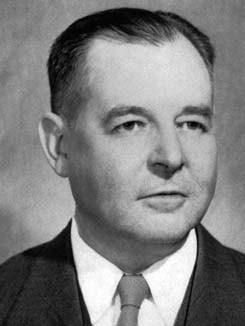| Profile | Major Works | Resources |
Harold Hotelling, 1895-1973.


Harold Hotelling's articles on econoimcs were few, but his contributions were profound enough to make him one of the "leaders" of the Paretian revival, the "resurrectors" the Marginalist Revolution in the 1930s.
Born in Minnesota, and raised in Seattle, Harold Hotelling studied journalism at the University of Washington, before going on to take a master's in mathematics. He obtained his Ph.D. in mathematics from Princeton in 1924, and obtained his first appointment at Stanford in 1924. Hotelling's first ventures into economics and statistics started almost immediately. Harold Hotelling was appointed as a professor of economics at Columbia in 1931 (then a stronghold of the American Institutionalist school) to replace Henry L. Moore.
Hotelling's 1929 paper on the stability of competition introduced the notion of spatial competition in a duopoly situation. The solution to this problem was in fact an early statement of a very well-known game-theoretic solution concept: the subgame-perfect equilibrium (as later defined by Selten.). His 1929 paper on depreciation provided its modern definition as the decline in discounted future values. In 1931, he advanced another technique into economics, the calculus of variations, into a now famous analysis of resource exhaustion.
Hotelling's 1932 piece reworked the theory of production into a choice-theoretic framework based on profit-maximization, setting the foundations of the modern Neoclassical approach. His 1935 derivation of demand was actually simultaneous with that of Hicks and Allen. His famous 1938 presidential address to the Econometric Society introduced the "marginal cost pricing" equilibrium as a general welfare proposition: roughly, that economic efficiency is achieved if every good is produced and priced at marginal cost. This would be the foundation of the Fundamental Welfare Theorems of Paretian general equilibrium theory. It was also here that he introduced his famous "two-part" tariff as an alternative solution in situations of natural monopoly.
One can argue that Harold Hotelling was a statistician first, economist second. He spent the second half of 1929 working under R.A. Fisher in England. Hotelling's work in mathematical statistics included his famous 1931 paper on the Student's t distribution for hypothesis testing, in which he laid out what has since been called "confidence intervals". At Columbia, he ensured that the economics students under him were well immersed in statistical theory. He trained both Kenneth Arrow and Milton Friedman, and was instrumental in the appointment of Abraham Wald.
Hotelling left Columbia in 1946, and became professor of economics and statistics at the University of North Carolina.
|
Major Works of Harold Hotelling
|
|
HET
|
|
Resources on Harold Hotelling
|
All rights reserved, Gonšalo L. Fonseca
